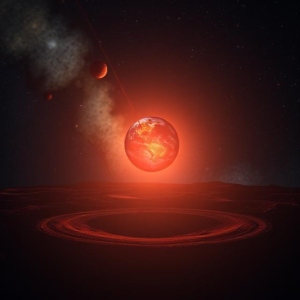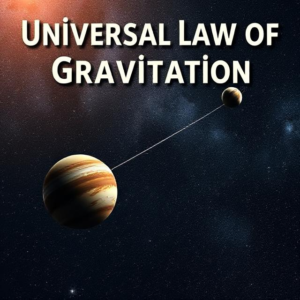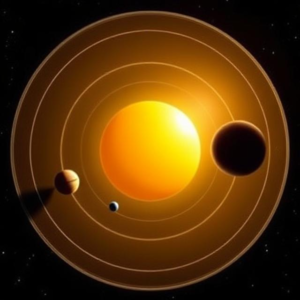What is Gravitation?
Gravitation is the force that attracts objects toward each other. It’s the reason why things fall to the ground when you drop them and why planets move around the Sun.
- Gravity is the force that pulls objects towards each other. The Earth’s gravity pulls everything towards its center, which is why things fall when you drop them.
- Gravity works between all objects, whether they are big like planets or small like a book.

Newton’s Law of Gravitation:
Isaac Newton, in the 17th century, came up with a law to explain how gravity works. It’s called Newton’s Law of Universal Gravitation, and it says:
Every object in the universe attracts every other object with a force that is directly proportional to the product of their masses and inversely proportional to the square of the distance between their centers.
Let’s break that down:
- “Every object in the universe attracts every other object”:
- This means that gravity isn’t just something that happens on Earth. Every object (no matter how small or large) pulls on every other object with a force. For example, the Earth pulls on the Moon, and the Moon also pulls on the Earth.
- “The force is directly proportional to the product of their masses”:
- Mass refers to how much matter an object has.
- The more massive an object is, the stronger its gravitational pull.
- For example, the Sun is much more massive than the Earth, so the Sun’s gravitational pull is much stronger than Earth’s pull.
- “And inversely proportional to the square of the distance between their centers”:
- The distance refers to how far apart the centers of two objects are (for example, the distance between the center of the Earth and the center of the Moon).
- The “square of the distance” means that if the distance between the two objects doubles, the gravitational force becomes four times weaker. If the distance triples, the force becomes nine times weaker, and so on.
The Formula:
The formula for Newton’s Law of Gravitation looks like this:
Where:
- F is the gravitational force between the two objects.
- G is the gravitational constant (a very small number, 6.674 × 10^-11 N·m²/kg²).
- m₁ and m₂ are the masses of the two objects.
- r is the distance between the centers of the two objects.
Putting it all together:
This formula tells us that the force of gravity between two objects depends on:
- The mass of each object (bigger masses = stronger gravity).
- The distance between the objects (greater distance = weaker gravity).
Example:
Let’s say we have:
- A small ball with a mass of 1 kg.
- A larger ball with a mass of 10 kg.
- The distance between them is 1 meter.
Using the formula, we can calculate the gravitational force between the two objects. But, in general, you can understand that:
- If you had a more massive object (like a planet), the force would be much stronger.
- If the two objects were farther apart, the force would be weaker.
Why Is This Important?
Newton’s Law of Gravitation explains:
- Why things fall to the ground: The Earth attracts objects towards it because of gravity.
- Why the Moon orbits the Earth: The Earth pulls on the Moon, and the Moon pulls on the Earth. The Earth’s gravity keeps the Moon in orbit.
- Why the planets orbit the Sun: The Sun’s gravity pulls the planets, keeping them in their orbits.
Imagine you have two objects:
- A small rock and a huge planet.
- The rock has a small gravitational pull, and the planet has a huge one.
- If the rock is really far from the planet, the gravitational force between them will be weak.
- If the rock is closer to the planet, the gravitational pull will be stronger.
Summary:
- Gravitation is the force that attracts all objects to each other.
- Newton’s Law of Gravitation says that every object pulls on every other object with a force that depends on their masses and the distance between them.
- This force is stronger when objects are bigger (more massive) and closer together.











